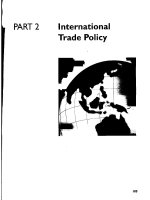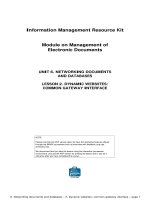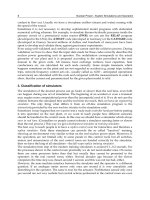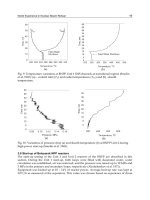Networking Theory and Fundamentals - Lecture 2 potx
Bạn đang xem bản rút gọn của tài liệu. Xem và tải ngay bản đầy đủ của tài liệu tại đây (415.27 KB, 37 trang )
1
TCOM 501:
Networking Theory & Fundamentals
Lecture 2
January 22, 2003
Prof. Yannis A. Korilis
2-2
Topics
Delay in Packet Networks
Introduction to Queueing Theory
Review of Probability Theory
The Poisson Process
Little’s Theorem
Proof and Intuitive Explanation
Applications
2-3
Sources of Network Delay
Processing Delay
Assume processing power is not a constraint
Queueing Delay
Time buffered waiting for transmission
Transmission Delay
Propagation Delay
Time spend on the link – transmission of electrical signal
Independent of traffic carried by the link
Focus: Queueing & Transmission Delay
2-4
Basic Queueing Model
Arrivals
Departures
Buffer Server(s)
Queued In Service
A queue models any service station with:
One or multiple servers
A waiting area or buffer
Customers arrive to receive service
A customer that upon arrival does not find a
free server is waits in the buffer
2-5
Characteristics of a Queue
m
b
Number of servers m: one, multiple, infinite
Buffer size b
Service discipline (scheduling): FCFS, LCFS,
Processor Sharing (PS), etc
Arrival process
Service statistics
2-6
Arrival Process
n
1n
−
1n
+
n
τ
n
t
t
: interarrival time between customers
n
and
n
+1
is a random variable
is a stochastic process
Interarrival times are identically distributed and have
a common mean
λ is called the arrival rate
n
τ
n
τ
{, 1}
n
n
τ
≥
[] []1/
n
EE
τ
τλ
=
=
2-7
Service-Time Process
n
1n
−
1n
+
n
s
t
: service time of customer n at the server
is a stochastic process
Service times are identically distributed with common mean
µ is called the service rate
For packets, are the service times really random?
n
s
{, 1}
n
sn≥
[] []
n
Es Es
µ
=
=
2-8
Queue Descriptors
Generic descriptor: A/S/m/k
A denotes the arrival process
For Poisson arrivals we use M (for Markovian)
B denotes the service-time distribution
M: exponential distribution
D: deterministic service times
G: general distribution
m is the number of servers
k is the max number of customers allowed in the
system – either in the buffer or in service
k is omitted when the buffer size is infinite
2-9
Queue Descriptors: Examples
M/M/1: Poisson arrivals, exponentially distributed
service times, one server, infinite buffer
M/M/m: same as previous with m servers
M/M/m/m: Poisson arrivals, exponentially distributed
service times, m server, no buffering
M/G/1: Poisson arrivals, identically distributed service
times follows a general distribution, one server,
infinite buffer
*/D/∞ : A constant delay system
2-10
Probability Fundamentals
Exponential Distribution
Memoryless Property
Poisson Distribution
Poisson Process
Definition and Properties
Interarrival Time Distribution
Modeling Arrival and Service Statistics
2-11
The Exponential Distribution
A continuous RV X follows the exponential distribution
with parameter µ, if its probability density function is:
Probability distribution function:
if 0
()
0if 0
x
X
ex
fx
x
µ
µ
−
≥
=
<
1if 0
() { }
0if 0
x
X
ex
Fx PX x
x
µ
−
−
≥
=≤=
<
2-12
Exponential Distribution (cont.)
Mean and Variance:
Proof:
2
11
[] , Var()EX X
µ
µ
==
00
0
0
22 2
0
2
00
22
22 2
[] ()
1
22
[] 2 []
21 1
Var( ) [ ] ( [ ])
x
X
xx
xx x
EX xf xdx x e dx
xe e dx
E X x e dx x e xe dx E X
XEX EX
µ
µµ
µµ µ
µ
µ
µ
µ
µ
µµµ
∞∞
−
∞
−∞ −
∞∞
−−∞−
===
=− + =
==−+==
= − =−=
∫∫
∫
∫∫
2-13
Memoryless Property
Past history has no influence on the future
Proof:
Exponential: the only continuous distribution with the
memoryless property
{|}{}
P
XxtXt PXx>+ > = >
()
{
,
}{ }
{|}
{} {}
{}
xt
x
t
PX x tX t PX x t
PX x t X t
PX t PX t
e
ePXx
e
µ
µ
µ
−+
−
−
>+ > >+
>+ > = =
>>
===>
2-14
Poisson Distribution
A discrete RV X follows the Poisson distribution with
parameter
λ if its probability mass function is:
Wide applicability in modeling the number of random
events that occur during a given time interval –
The
Poisson Process
:
Customers that arrive at a post office during a day
Wrong phone calls received during a week
Students that go to the instructor’s office during office hours
… and packets that arrive at a network switch
{} , 0,1,2,
!
k
PX k e k
k
λ
λ
−
== =
2-15
Poisson Distribution (cont.)
Mean and Variance
Proof:
[] , Var()EX X
λ
λ
=
=
000
0
22 2
000
2
00 0
222
[] { }
!(1)!
!
[] { }
!(1)!
(1)
!!!
Var( ) [ ] ( [ ])
kk
kkk
j
j
kk
kkk
jjj
jj j
EX kPX k e k e
kk
eee
j
EX kPXkek ek
kk
ej je e
jjj
XEX EX
λλ
λλλ
λλ
λλλ
λλ
λ
λλλ
λλ
λλλ
λ
λλλλ
λ
∞∞∞
−−
===
∞
−−
=
∞∞∞
−−
===
∞∞ ∞
−−−
== =
=== =
−
===
=== =
−
=+= + =+
=− =+
∑∑∑
∑
∑∑∑
∑∑ ∑
2
λλ λ
−=
2-16
Sum of Poisson Random Variables
X
i
, i =1,2,…,n, are independent RVs
X
i
follows Poisson distribution with parameter λ
i
Partial sum defined as:
S
n
follows Poisson distribution with parameter λ
12
nn
SXX X
=
+++
12
n
λ
λλ λ
=
+++
2-17
Sum of Poisson Random Variables (cont.)
Proof: For n = 2. Generalization by induc-
tion. The pmf of S = X
1
+ X
2
is
P
f
S = m
g
=
m
X
k
=0
P
f
X
1
= k; X
2
= m
¡
k
g
=
m
X
k
=0
P
f
X
1
=
k
g
P
f
X
2
=
m
¡
k
g
=
m
X
k
=0
e
¡¸
1
¸
k
1
k!
¢
e
¡¸
2
¸
m¡k
2
(m
¡
k)!
= e
¡(
¸
1
+
¸
2
)
1
m!
m
X
k
=0
m!
k!(m
¡
k)!
¸
k
1
¸
m¡k
2
= e
¡(¸
1
+¸
2
)
(¸
1
+ ¸
2
)
m
m!
Poisson with parameter ¸ = ¸
1
+ ¸
2
.
2-18
Sampling a Poisson Variable
X follows Poisson distribution with parameter λ
Each of the X arrivals is of type i with probability p
i
,
i =1,2,…,n, independently of other arrivals;
p
1
+ p
2
+…+ p
n
= 1
X
i
denotes the number of type i arrivals
X
1
, X
2
,…X
n
are independent
X
i
follows Poisson distribution with parameter λ
i
= λp
i
2-19
Sampling a Poisson Variable (cont.)
Proof: For n = 2. Generalize by induction. Joint pmf:
P
f
X
1
= k
1
;X
2
= k
2
g
=
= P
f
X
1
= k
1
;X
2
= k
2
j
X = k
1
+ k
2
g
P
f
X = k
1
+ k
2
g
=
³
k
1
+
k
2
k
1
´
p
k
1
1
p
k
2
2
¢
e
¡
¸
¸
k
1
+k
2
(k
1
+ k
2
)!
=
1
k
1
!
k
2
!
(¸p
1
)
k
1
(¸p
2
)
k
2
¢
e
¡
¸(p
1
+p
2
)
= e
¡
¸p
1
(
¸p
1
)
k
1
k
1
!
¢
e
¡
¸p
2
(
¸p
2
)
k
2
k
2
!
²
X
1
and
X
2
are independent
²
P
f
X
1
= k
1
g
= e
¡
¸p
1
(¸p
1
)
k
1
k
1
!
, P
f
X
2
= k
2
g
= e
¡
¸p
2
(¸p
2
)
k
2
k
2
!
X
i
follows Poisson distribution with parameter
¸p
i
.
2-20
Poisson Approximation to Binomial
Binomial distribution with
parameters (n, p)
As n→∞ and p→0, with np=λ
moderate, binomial distribution
converges to Poisson with
parameter λ
Proof:
{} (1)
(1) (1)
1
( 1) ( 1)
1
1
11
{}
!
!
knk
nk
n
k
n
n
k
n
k
k
n
n
PX k p p
k
nk n n
nn
nk n n
n
e
n
n
P
k
k
Xk e
λ
λ
λ
λ
λ
λ
λ
−
−
→∞
−
→∞
→∞
−
→∞
== −
−+ −
=⋅−
−+ −
→
−→
−→
=→
{} (1)
knk
n
PX k p p
k
−
== −
2-21
Poisson Process with Rate λ
{A(t): t≥0} counting process
A(t) is the number of events (arrivals) that have occurred from
time 0 – when A(0)=0 – to time t
A(t)-A(s) number of arrivals in interval (s, t]
Number of arrivals in disjoint intervals independent
Number of arrivals in any interval (t, t+τ] of length τ
Depends only on its length τ
Follows Poisson distribution with parameter λτ
Average number of arrivals λτ; λ is the
arrival rate
()
{( ) () } , 0,1,
!
n
PAt At n e n
n
λτ
λτ
τ
−
+− == =
2-22
Interarrival-Time Statistics
Interarrival times for a Poisson process are independent
and follow exponential distribution with parameter λ
t
n
: time of n
th
arrival; τ
n
=t
n+1
-t
n
: n
th
interarrival time
{}1 , 0
s
n
Ps es
λ
τ
−
≤
=− ≥
Proof:
Probability distribution function
Independence follows from independence of number of arrivals in
disjoint intervals
{ }1 { }1 {( ) () 0}1
s
nn nn
P
sPsPAtsAt e
λ
ττ
−
≤=− >=− +− ==−
2-23
Small Interval Probabilities
Interval (t+ δ, t] of length δ
{( ) () 0} 1 ()
{( ) () 1} ()
{( ) () 2} ()
PAt At
PAt At
PAt At
δ
λδ ο δ
δλδοδ
δοδ
+− ==− +
+− == +
+− ≥=
Proof:
2
2
1
0
()
{( ) () 0} 1 1 ()
2
()
{( ) () 1} 1 ()
2
{( ) () 2} 1 {( ) () }
1(1 ())( ()) ()
k
PAt At e
PAt At e
PAt At PAt At k
λδ
λδ
λδ
δλδλδοδ
λδ
δ
λδ λδ λδ λδ ο δ
δδ
λδ ο δ λδ ο δ ο δ
−
−
=
+− == =− + =− +
+− == = − + = +
+− ≥=− +− =
=− − + − + =
∑
2-24
Merging & Splitting Poisson Processes
λ
pλ
1
p
1-p
λ
λ
1
+ λ
2
λ(1-p)
λ
2
A
1
,…, A
k
independent Poisson
processes with rates λ
1
,…, λ
k
Merged in a single process
A= A
1
+…+ A
k
A is Poisson process with rate
λ= λ
1
+…+ λ
k
A: Poisson processes with rate λ
Split into processes A
1
and A
2
independently, with probabilities p
and 1-p respectively
A
1
is Poisson with rate λ
1
= λp
A
2
is Poisson with rate λ
2
= λ(1-p)
2-25
Modeling Arrival Statistics
Poisson process widely used to model packet arrivals
in numerous networking problems
Justification: provides a good model for aggregate
traffic of a large number of “independent” users
n traffic streams, with independent identically distributed (iid)
interarrival times with PDF F(s) – not necessarily exponential
Arrival rate of each stream λ/n
As n→∞, combined stream can be approximated by Poisson
under mild conditions on F(s) – e.g., F(0)=0, F’(0)>0
☺ Most important reason for Poisson assumption:
Analytic tractability of queueing models









